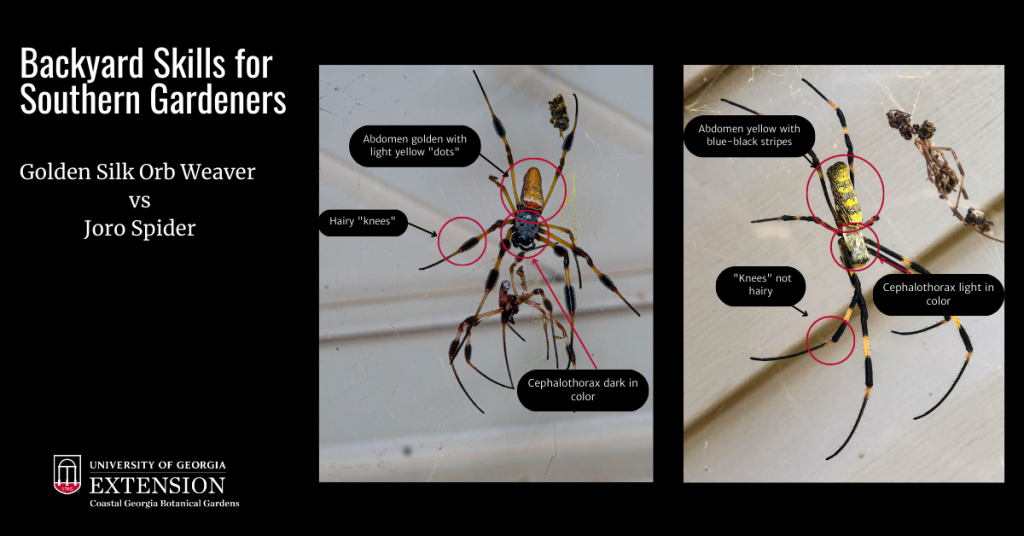In the world of arachnids, spiders come in all shapes and sizes, showcasing a stunning diversity of colors, patterns, and behaviors. Among these fascinating creatures, the Joro spider and the Golden Silk Orb Weaver stand out as formidable and captivating representatives of their kind. Both renowned for their intricate web-building abilities, these spiders have unique characteristics that set them apart in the world of silk-spinning arachnids. Let’s delve into the duel between the Joro spider and the Golden Silk Orb Weaver.
The Golden Silk Orb Weaver is a native to both North and South America. It is sometimes also called the Banana Spider. The Joro Spider is a native to Asia and was recently found in North Georgia and South Carolina. Let’s get the important thing out of the way. Neither of these spiders is dangerous to humans or our pets – except for the occasional heart attack that may be caused by accidentally walking through the webs.

Credit: Golden Silk Orb Weaver Dr. Tim Davis, Director CGBG. Joro Spider Alana Edwards, Chatham/CGBG ANR Educator
Round 1: Appearance and Size
The Joro spider (Nephila clavata) and the Golden Silk Orb Weaver (Nephila clavipes) share some similarities in appearance due to their shared genus, Nephila. Even their scientific names are similar. They are often confused with each other, however, they have some distinct features that distinguish them from one another.
The Joro spider, native to Japan, is recognized for its vibrant and eye-catching colors. The females boast a mix of striking yellow and black markings on their abdomens, making them easily recognizable in their natural habitat. The legs do not have tufts of hair around the joints. The abdomen is bright yellow with blue-black bands on the ventral surface. The cephalothorax is light in color. On the other hand, males have a more subdued appearance, featuring a brown and tan palette.
In comparison, the Golden Silk Orb Weaver has hairy tufts around the leg joints. The cephalothorax is usually dark almost black. The abdomen is golden colored with light yellow dots.
In terms of size, the Golden Silk Orb Weaver generally takes the lead. The females of this species can reach a length of about 1.5 to 2 inches (3.8 to 5 centimeters) for the body, with legs spanning even more considerable lengths. Joro spiders, while impressive in their own right, usually have slightly smaller body sizes, with females measuring around 0.7 to 1.2 inches (1.8 to 3 centimeters).

Round 2: Web-building Skills
When it comes to web-building prowess, both the Joro spider and the Golden Silk Orb Weaver are masters of their craft. However, their techniques differ significantly.
The Golden Silk Orb Weaver, as the name suggests, is renowned for its impressive golden silk. The silk threads it produces are incredibly strong and durable, capable of capturing even large insects such as butterflies and grasshoppers. Their orb-shaped webs are meticulously designed, often spanning several feet in diameter, strategically placed in areas where they are most likely to intercept their prey.
On the other hand, the Joro spider prefers to spin its web closer to the ground, usually between shrubs and low-hanging branches. Their webs often appear more chaotic, with an irregular mesh of silk, but it serves the purpose of ensnaring smaller flying insects that happen to wander into their territory.
Round 3: Hunting Strategies
The hunting techniques of these two spiders are reflective of their web designs. The Golden Silk Orb Weaver, with its expansive and highly organized web, relies on its impressive size and strength to overpower and immobilize its prey once ensnared in the sticky threads. These spiders are patient predators, often waiting motionlessly at the center of their webs for the vibrations signaling the arrival of a trapped insect.
The Joro spider, despite its smaller web, is equally effective in its hunting strategy. It often rests at the center of its web, waiting for unsuspecting insects to blunder into its trap. As soon as an insect makes contact, the Joro spider swiftly rushes to its prey to deliver a venomous bite, effectively incapacitating its catch.
Round 4: Social Behavior
In contrast to the solitary nature of most spider species, both the Joro spider and the Golden Silk Orb Weaver exhibit interesting social behaviors, although they differ in their approach.
Golden Silk Orb Weavers, particularly females, can be found living together in large colonies, where they cooperatively build webs and share resources. This cooperative behavior provides them with some advantages, such as increased protection and improved chances of successful reproduction.
The Joro spider, however, displays social behavior in a different way. In their colonies, each female typically constructs her individual web, and these webs can be quite close to one another, leading to a somewhat communal living arrangement. Despite this proximity, interactions between individual Joro spiders are limited.
Final Verdict: A Matter of Adaptation
In this intense battle between the Joro spider and the Golden Silk Orb Weaver, there is no clear winner. Both spiders are remarkable in their own right, equipped with unique characteristics and strategies that suit their respective environments and hunting preferences.
The Golden Silk Orb Weaver dazzles with its impressive size, stunning golden silk, and cooperative social behavior. On the other hand, the Joro spider captivates with its vibrant appearance and ability to thrive in close-knit communities.
Ultimately, the winner of this battle is not determined by their prowess in combat, but rather by their remarkable adaptations that have allowed them to survive and flourish in the ever-evolving world of arachnids. Both the Joro spider and the Golden Silk Orb Weaver stand as testaments to the incredible diversity and wonder of the natural world.